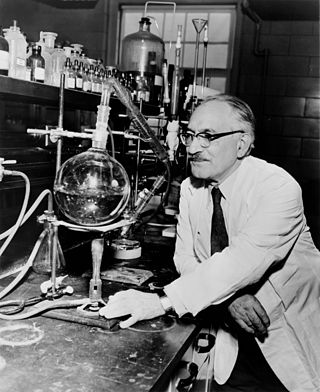Related Research Articles

An antibiotic is a type of antimicrobial substance active against bacteria. It is the most important type of antibacterial agent for fighting bacterial infections, and antibiotic medications are widely used in the treatment and prevention of such infections. They may either kill or inhibit the growth of bacteria. A limited number of antibiotics also possess antiprotozoal activity. Antibiotics are not effective against viruses such as the ones which cause the common cold or influenza; drugs which inhibit growth of viruses are termed antiviral drugs or antivirals rather than antibiotics. They are also not effective against fungi; drugs which inhibit growth of fungi are called antifungal drugs.

Erythromycin is an antibiotic used for the treatment of a number of bacterial infections. This includes respiratory tract infections, skin infections, chlamydia infections, pelvic inflammatory disease, and syphilis. It may also be used during pregnancy to prevent Group B streptococcal infection in the newborn, and to improve delayed stomach emptying. It can be given intravenously and by mouth. An eye ointment is routinely recommended after delivery to prevent eye infections in the newborn.

Macrolides are a class of mostly natural products with a large macrocyclic lactone ring to which one or more deoxy sugars, usually cladinose and desosamine, may be attached. The lactone rings are usually 14-, 15-, or 16-membered. Macrolides belong to the polyketide class of natural products. Some macrolides have antibiotic or antifungal activity and are used as pharmaceutical drugs. Rapamycin is also a macrolide and was originally developed as an antifungal, but is now used as an immunosuppressant drug and is being investigated as a potential longevity therapeutic.

Streptomycin is an antibiotic medication used to treat a number of bacterial infections, including tuberculosis, Mycobacterium avium complex, endocarditis, brucellosis, Burkholderia infection, plague, tularemia, and rat bite fever. For active tuberculosis it is often given together with isoniazid, rifampicin, and pyrazinamide. It is administered by injection into a vein or muscle.
The Thermomicrobia is a group of thermophilic green non-sulfur bacteria. Based on species Thermomicrobium roseum and Sphaerobacter thermophilus, this bacteria class has the following description:

Selman Abraham Waksman was a Jewish Ukrainian inventor, Nobel Prize laureate, biochemist and microbiologist whose research into the decomposition of organisms that live in soil enabled the discovery of streptomycin and several other antibiotics. A professor of biochemistry and microbiology at Rutgers University for four decades, he discovered several antibiotics, and he introduced procedures that have led to the development of many others. The proceeds earned from the licensing of his patents funded a foundation for microbiological research, which established the Waksman Institute of Microbiology located at the Rutgers University Busch Campus in Piscataway, New Jersey (USA). In 1952, he was awarded the Nobel Prize in Physiology or Medicine for "ingenious, systematic, and successful studies of the soil microbes that led to the discovery of streptomycin." Waksman and his foundation later were sued by Albert Schatz, one of his Ph.D. students and the discoverer of streptomycin, for minimizing Schatz's role in the discovery.

Bacitracin is a polypeptide antibiotic. It is a mixture of related cyclic peptides produced by Bacillus licheniformis bacteria, that was first isolated from the variety "Tracy I" in 1945. These peptides disrupt gram-positive bacteria by interfering with cell wall and peptidoglycan synthesis.

At 150.4 miles (242.0 km), Lechuguilla Cave is the eighth-longest explored cave in the world and the second deepest in the continental United States. It is most famous for its unusual geology, rare formations, and pristine condition.

Albert Israel Schatz was an American microbiologist and academic who discovered streptomycin, the first antibiotic known to be effective for the treatment of tuberculosis. He graduated from Rutgers University in 1942 with a bachelor's degree in soil microbiology, and received his doctorate from Rutgers in 1945. His PhD research led directly to the discovery of streptomycin.
Production of antibiotics is a naturally occurring event, that thanks to advances in science can now be replicated and improved upon in laboratory settings. Due to the discovery of penicillin by Alexander Fleming, and the efforts of Florey and Chain in 1938, large-scale, pharmaceutical production of antibiotics has been made possible. As with the initial discovery of penicillin, most antibiotics have been discovered as a result of happenstance. Antibiotic production can be grouped into three methods: natural fermentation, semi-synthetic, and synthetic. As more and more bacteria continue to develop resistance to currently produced antibiotics, research and development of new antibiotics continues to be important. In addition to research and development into the production of new antibiotics, repackaging delivery systems is important to improving efficacy of the antibiotics that are currently produced. Improvements to this field have seen the ability to add antibiotics directly into implanted devices, aerosolization of antibiotics for direct delivery, and combination of antibiotics with non antibiotics to improve outcomes. The increase of antibiotic resistant strains of pathogenic bacteria has led to an increased urgency for the funding of research and development of antibiotics and a desire for production of new and better acting antibiotics.

The disk diffusion test is a culture-based microbiology assay used in diagnostic and drug discovery laboratories. In diagnostic labs, the assay is used to determine the susceptibility of bacteria isolated from a patient's infection to clinically approved antibiotics. This allows physicians to prescribe the most appropriate antibiotic treatment. In drug discovery labs, especially bioprospecting labs, the assay is used to screen biological material and drug candidates for antibacterial activity. When bioprospecting, the assay can be performed with paired strains of bacteria to achieve dereplication and provisionally identify antibacterial mechanism of action.

Cefoxitin is a second-generation cephamycin antibiotic developed by Merck & Co., Inc. from Cephamycin C in the year following its discovery, 1972. It was synthesized in order to create an antibiotic with a broader spectrum. It is often grouped with the second-generation cephalosporins. Cefoxitin requires a prescription and as of 2010 is sold under the brand name Mefoxin by Bioniche Pharma, LLC. The generic version of cefoxitin is known as cefoxitin sodium.

Oleandomycin is a macrolide antibiotic. It is synthesized from strains of Streptomyces antibioticus. It is weaker than erythromycin.

Streptomyces griseus is a species of bacteria in the genus Streptomyces commonly found in soil. A few strains have been also reported from deep-sea sediments. It is a Gram-positive bacterium with high GC content. Along with most other streptomycetes, S. griseus strains are well known producers of antibiotics and other such commercially significant secondary metabolites. These strains are known to be producers of 32 different structural types of bioactive compounds. Streptomycin, the first antibiotic ever reported from a bacterium, comes from strains of S. griseus. Recently, the whole genome sequence of one of its strains had been completed.

Amycolatopsis orientalis is a Gram-positive bacterium in the phylum Actinomycetota. It produces several substances with antimicrobial properties, including the antibiotic drug vancomycin.

Edmund Carl Kornfeld was an American organic chemist who devoted his life to the research of new drugs. His leading discovery, with the help of a team, was an antibiotic that was later named vancomycin.

Carbomycin, also known as magnamycin, is a colorless, optically active crystalline macrolide antibiotic with the molecular formula C42H67N O16. It is derived from the bacterium Streptomyces halstedii and active in inhibiting the growth of Gram-positive bacteria and "certain Mycoplasma strains." Its structure was first proposed by Robert Woodward in 1957 and was subsequently corrected in 1965.
Teixobactin is a peptide-like secondary metabolite of some species of bacteria, that kills some gram-positive bacteria. It appears to belong to a new class of antibiotics, and harms bacteria by binding to lipid II and lipid III, important precursor molecules for forming the cell wall.

Allokutzneria albata is a bacterium from the genus Allokutzneria which has been isolated from soil from the Mindanao Island on the Philippines. Allokutzneria albata produces the antivirals cycloviracin B1 and cycloviracin B2 as well as the antibiotic sequanamycin A (SEQ-503), a 14-membered ring erythromycin family macrolide against Mycobacterium tuberculosis, which was discovered in 1969.
References
- ↑ Francisco, Mikael Angelo (20 April 2020). "The Ilonggo who discovered erythromycin—and got shafted for it - FlipScience". FlipScience - Top Philippine science news and features for the inquisitive Filipino. flip science. Archived from the original on 3 March 2021. Retrieved 4 November 2021.
- ↑ "Dr. Abelardo Aguilar Biography". www.whenwasborn.wiki. Retrieved 27 September 2023.
- ↑ Seereeram, Sanjivani. "Dr. Aguilar's Antibiotic Discovery in the Philippines". multiculturalmuseums.org. Archived from the original on 13 October 2021. Retrieved 4 November 2021.
- ↑ Shah, Falguni (1 April 1998). "Erythromycin". Pediatrics in Review. 19 (4): 140–141. doi:10.1542/pir.19-4-140. ISSN 0191-9601. PMID 9557068. Archived from the original on 4 November 2021. Retrieved 4 November 2021.
- ↑ "The underrated Filipino". Manila Times. Archived from the original on 12 October 2019. Retrieved 4 November 2021.
- ↑ Son, Johanna (9 November 1994). "MEDICINE-PHILIPPINES: Who Really Discovered Erythromycin?". Inter Press Service. Archived from the original on 28 August 2021. Retrieved 4 November 2021.
- ↑ "Ban on Antibiotic Ilosone Urged; Eli Lilly Defends Drug's Record". The New York Times. 25 April 1973. Archived from the original on 4 November 2021. Retrieved 4 November 2021.
- ↑ November 21, carlyo on. "Role Models in Science & Engineering Achievement: Abelardo Aguilar | ScienceBlogs". scienceblogs.com. Archived from the original on 2015-03-16. Retrieved 2021-11-04.
{{cite web}}: CS1 maint: numeric names: authors list (link) - ↑ Hibionada, Florence F. "Remembering the battle of Dr. Abelardo Aguilar:Cure for millions, deprived of millions". www.thenewstoday.info. Archived from the original on 2021-09-18. Retrieved 2021-11-04.
- ↑ Tan, Michael L. (30 August 2019). "Drugs and rights". INQUIRER.net. Archived from the original on 28 February 2021. Retrieved 4 November 2021.